SCM 850: Scotts Miracle-Gro Case - Make vs. Outsource Analysis
VerifiedAdded on 2022/08/08
|8
|1249
|28
Case Study
AI Summary
This memorandum analyzes the supply chain of Scotts Miracle-Gro, specifically addressing the make-or-buy decision for their spreader product. The company is evaluating whether to continue in-house production at its Temecula facility or outsource manufacturing to a vendor in China. A detailed comparative analysis, including cost savings and additional expenses, is presented, considering both present and real values. The analysis utilizes Net Present Value (NPV) to compare the financial implications of each option over a 10-year period, revealing that outsourcing to China results in lower costs. The Lynch Approach "Why Outsource" is applied to support the outsourcing decision. The memorandum concludes with a recommendation to outsource production, highlighting the significant cost savings and capital appreciation potential. The impact of exchange rates, particularly the Euro, is also considered.

Running head: SUPPLY CHAIN DESIGN AND NETWORK
Supply Chain Design and Network
Name of the Student:
Name of the University:
Author’s Note:
Supply Chain Design and Network
Name of the Student:
Name of the University:
Author’s Note:
Paraphrase This Document
Need a fresh take? Get an instant paraphrase of this document with our AI Paraphraser
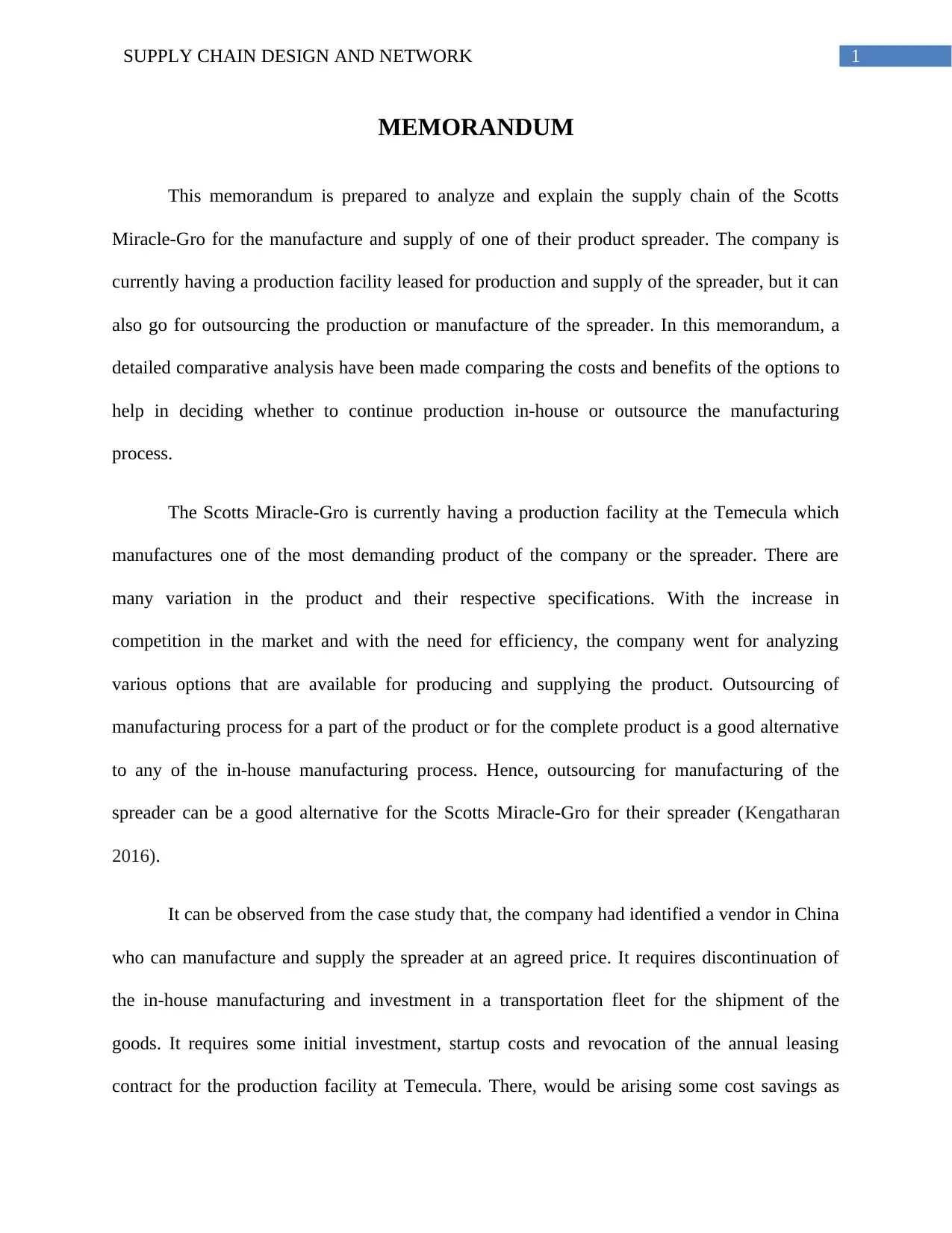
1SUPPLY CHAIN DESIGN AND NETWORK
MEMORANDUM
This memorandum is prepared to analyze and explain the supply chain of the Scotts
Miracle-Gro for the manufacture and supply of one of their product spreader. The company is
currently having a production facility leased for production and supply of the spreader, but it can
also go for outsourcing the production or manufacture of the spreader. In this memorandum, a
detailed comparative analysis have been made comparing the costs and benefits of the options to
help in deciding whether to continue production in-house or outsource the manufacturing
process.
The Scotts Miracle-Gro is currently having a production facility at the Temecula which
manufactures one of the most demanding product of the company or the spreader. There are
many variation in the product and their respective specifications. With the increase in
competition in the market and with the need for efficiency, the company went for analyzing
various options that are available for producing and supplying the product. Outsourcing of
manufacturing process for a part of the product or for the complete product is a good alternative
to any of the in-house manufacturing process. Hence, outsourcing for manufacturing of the
spreader can be a good alternative for the Scotts Miracle-Gro for their spreader (Kengatharan
2016).
It can be observed from the case study that, the company had identified a vendor in China
who can manufacture and supply the spreader at an agreed price. It requires discontinuation of
the in-house manufacturing and investment in a transportation fleet for the shipment of the
goods. It requires some initial investment, startup costs and revocation of the annual leasing
contract for the production facility at Temecula. There, would be arising some cost savings as
MEMORANDUM
This memorandum is prepared to analyze and explain the supply chain of the Scotts
Miracle-Gro for the manufacture and supply of one of their product spreader. The company is
currently having a production facility leased for production and supply of the spreader, but it can
also go for outsourcing the production or manufacture of the spreader. In this memorandum, a
detailed comparative analysis have been made comparing the costs and benefits of the options to
help in deciding whether to continue production in-house or outsource the manufacturing
process.
The Scotts Miracle-Gro is currently having a production facility at the Temecula which
manufactures one of the most demanding product of the company or the spreader. There are
many variation in the product and their respective specifications. With the increase in
competition in the market and with the need for efficiency, the company went for analyzing
various options that are available for producing and supplying the product. Outsourcing of
manufacturing process for a part of the product or for the complete product is a good alternative
to any of the in-house manufacturing process. Hence, outsourcing for manufacturing of the
spreader can be a good alternative for the Scotts Miracle-Gro for their spreader (Kengatharan
2016).
It can be observed from the case study that, the company had identified a vendor in China
who can manufacture and supply the spreader at an agreed price. It requires discontinuation of
the in-house manufacturing and investment in a transportation fleet for the shipment of the
goods. It requires some initial investment, startup costs and revocation of the annual leasing
contract for the production facility at Temecula. There, would be arising some cost savings as
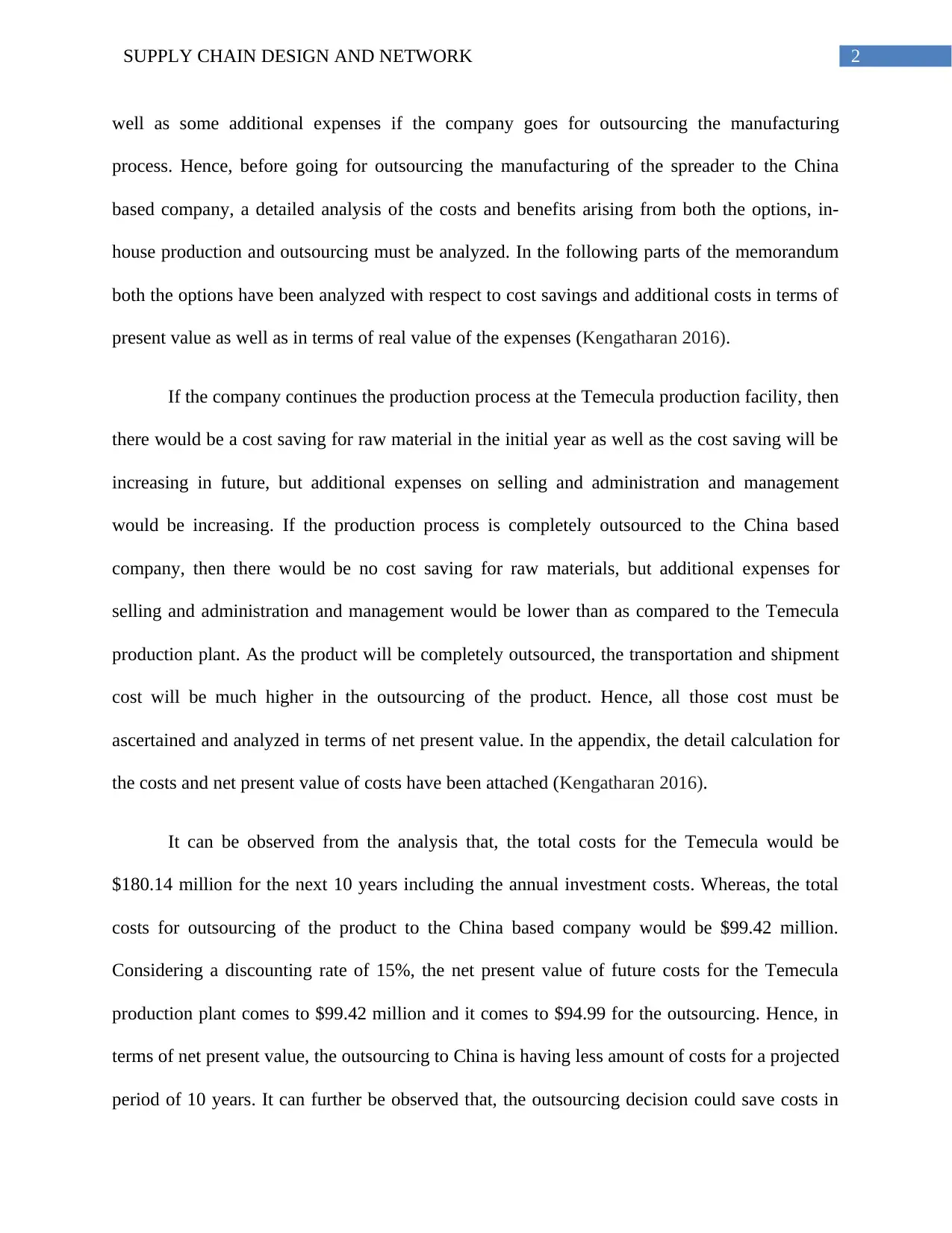
2SUPPLY CHAIN DESIGN AND NETWORK
well as some additional expenses if the company goes for outsourcing the manufacturing
process. Hence, before going for outsourcing the manufacturing of the spreader to the China
based company, a detailed analysis of the costs and benefits arising from both the options, in-
house production and outsourcing must be analyzed. In the following parts of the memorandum
both the options have been analyzed with respect to cost savings and additional costs in terms of
present value as well as in terms of real value of the expenses (Kengatharan 2016).
If the company continues the production process at the Temecula production facility, then
there would be a cost saving for raw material in the initial year as well as the cost saving will be
increasing in future, but additional expenses on selling and administration and management
would be increasing. If the production process is completely outsourced to the China based
company, then there would be no cost saving for raw materials, but additional expenses for
selling and administration and management would be lower than as compared to the Temecula
production plant. As the product will be completely outsourced, the transportation and shipment
cost will be much higher in the outsourcing of the product. Hence, all those cost must be
ascertained and analyzed in terms of net present value. In the appendix, the detail calculation for
the costs and net present value of costs have been attached (Kengatharan 2016).
It can be observed from the analysis that, the total costs for the Temecula would be
$180.14 million for the next 10 years including the annual investment costs. Whereas, the total
costs for outsourcing of the product to the China based company would be $99.42 million.
Considering a discounting rate of 15%, the net present value of future costs for the Temecula
production plant comes to $99.42 million and it comes to $94.99 for the outsourcing. Hence, in
terms of net present value, the outsourcing to China is having less amount of costs for a projected
period of 10 years. It can further be observed that, the outsourcing decision could save costs in
well as some additional expenses if the company goes for outsourcing the manufacturing
process. Hence, before going for outsourcing the manufacturing of the spreader to the China
based company, a detailed analysis of the costs and benefits arising from both the options, in-
house production and outsourcing must be analyzed. In the following parts of the memorandum
both the options have been analyzed with respect to cost savings and additional costs in terms of
present value as well as in terms of real value of the expenses (Kengatharan 2016).
If the company continues the production process at the Temecula production facility, then
there would be a cost saving for raw material in the initial year as well as the cost saving will be
increasing in future, but additional expenses on selling and administration and management
would be increasing. If the production process is completely outsourced to the China based
company, then there would be no cost saving for raw materials, but additional expenses for
selling and administration and management would be lower than as compared to the Temecula
production plant. As the product will be completely outsourced, the transportation and shipment
cost will be much higher in the outsourcing of the product. Hence, all those cost must be
ascertained and analyzed in terms of net present value. In the appendix, the detail calculation for
the costs and net present value of costs have been attached (Kengatharan 2016).
It can be observed from the analysis that, the total costs for the Temecula would be
$180.14 million for the next 10 years including the annual investment costs. Whereas, the total
costs for outsourcing of the product to the China based company would be $99.42 million.
Considering a discounting rate of 15%, the net present value of future costs for the Temecula
production plant comes to $99.42 million and it comes to $94.99 for the outsourcing. Hence, in
terms of net present value, the outsourcing to China is having less amount of costs for a projected
period of 10 years. It can further be observed that, the outsourcing decision could save costs in
⊘ This is a preview!⊘
Do you want full access?
Subscribe today to unlock all pages.

Trusted by 1+ million students worldwide
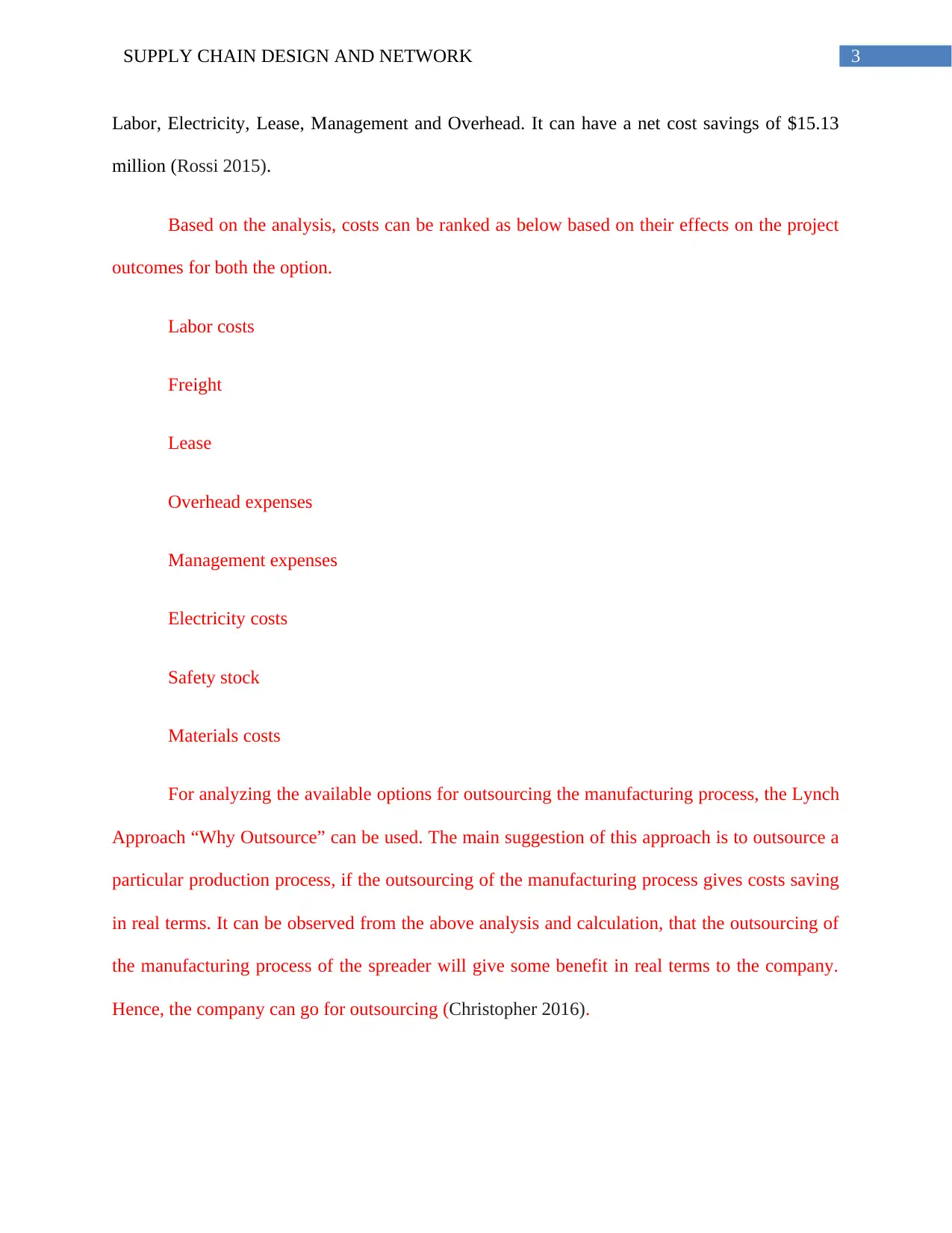
3SUPPLY CHAIN DESIGN AND NETWORK
Labor, Electricity, Lease, Management and Overhead. It can have a net cost savings of $15.13
million (Rossi 2015).
Based on the analysis, costs can be ranked as below based on their effects on the project
outcomes for both the option.
Labor costs
Freight
Lease
Overhead expenses
Management expenses
Electricity costs
Safety stock
Materials costs
For analyzing the available options for outsourcing the manufacturing process, the Lynch
Approach “Why Outsource” can be used. The main suggestion of this approach is to outsource a
particular production process, if the outsourcing of the manufacturing process gives costs saving
in real terms. It can be observed from the above analysis and calculation, that the outsourcing of
the manufacturing process of the spreader will give some benefit in real terms to the company.
Hence, the company can go for outsourcing (Christopher 2016).
Labor, Electricity, Lease, Management and Overhead. It can have a net cost savings of $15.13
million (Rossi 2015).
Based on the analysis, costs can be ranked as below based on their effects on the project
outcomes for both the option.
Labor costs
Freight
Lease
Overhead expenses
Management expenses
Electricity costs
Safety stock
Materials costs
For analyzing the available options for outsourcing the manufacturing process, the Lynch
Approach “Why Outsource” can be used. The main suggestion of this approach is to outsource a
particular production process, if the outsourcing of the manufacturing process gives costs saving
in real terms. It can be observed from the above analysis and calculation, that the outsourcing of
the manufacturing process of the spreader will give some benefit in real terms to the company.
Hence, the company can go for outsourcing (Christopher 2016).
Paraphrase This Document
Need a fresh take? Get an instant paraphrase of this document with our AI Paraphraser
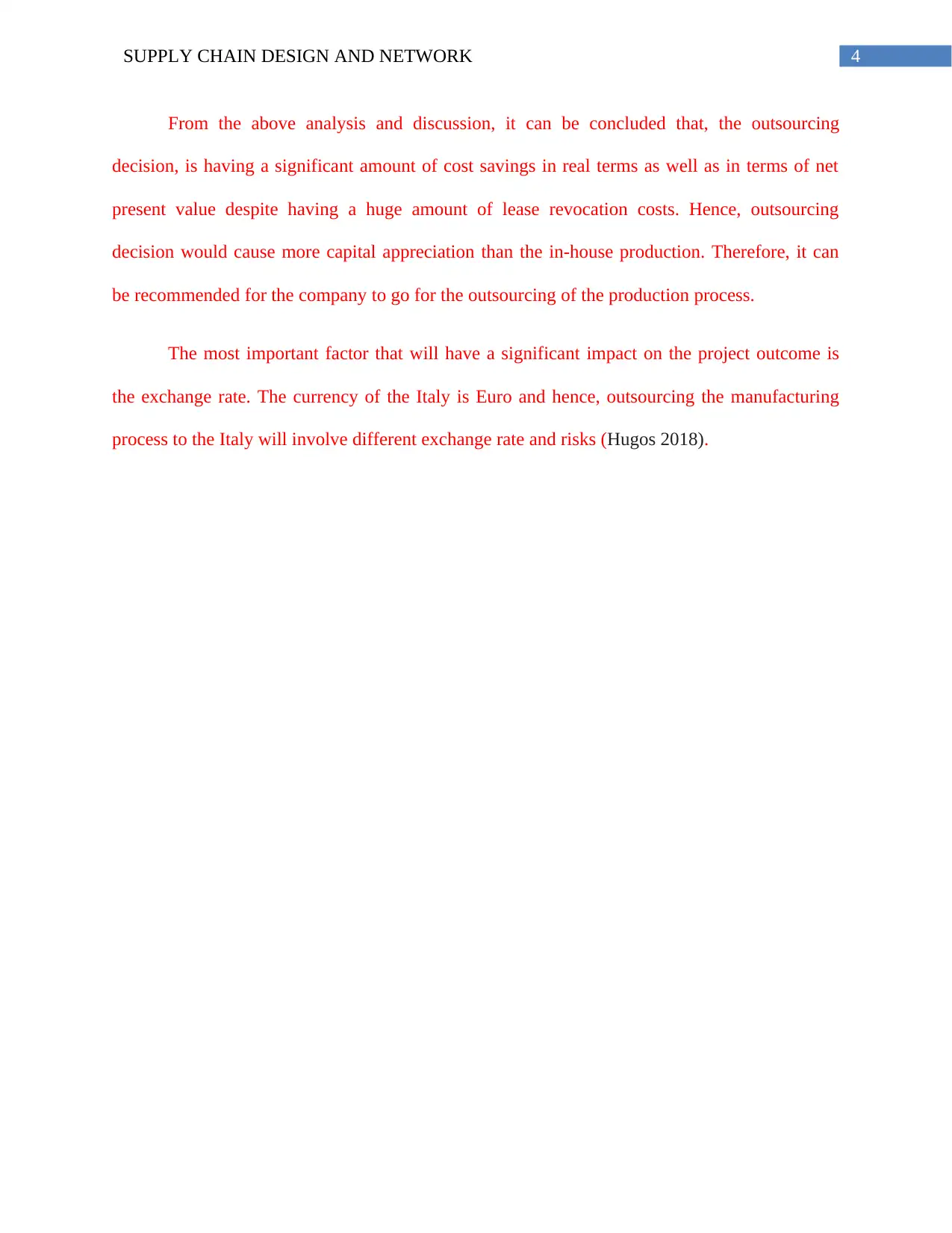
4SUPPLY CHAIN DESIGN AND NETWORK
From the above analysis and discussion, it can be concluded that, the outsourcing
decision, is having a significant amount of cost savings in real terms as well as in terms of net
present value despite having a huge amount of lease revocation costs. Hence, outsourcing
decision would cause more capital appreciation than the in-house production. Therefore, it can
be recommended for the company to go for the outsourcing of the production process.
The most important factor that will have a significant impact on the project outcome is
the exchange rate. The currency of the Italy is Euro and hence, outsourcing the manufacturing
process to the Italy will involve different exchange rate and risks (Hugos 2018).
From the above analysis and discussion, it can be concluded that, the outsourcing
decision, is having a significant amount of cost savings in real terms as well as in terms of net
present value despite having a huge amount of lease revocation costs. Hence, outsourcing
decision would cause more capital appreciation than the in-house production. Therefore, it can
be recommended for the company to go for the outsourcing of the production process.
The most important factor that will have a significant impact on the project outcome is
the exchange rate. The currency of the Italy is Euro and hence, outsourcing the manufacturing
process to the Italy will involve different exchange rate and risks (Hugos 2018).
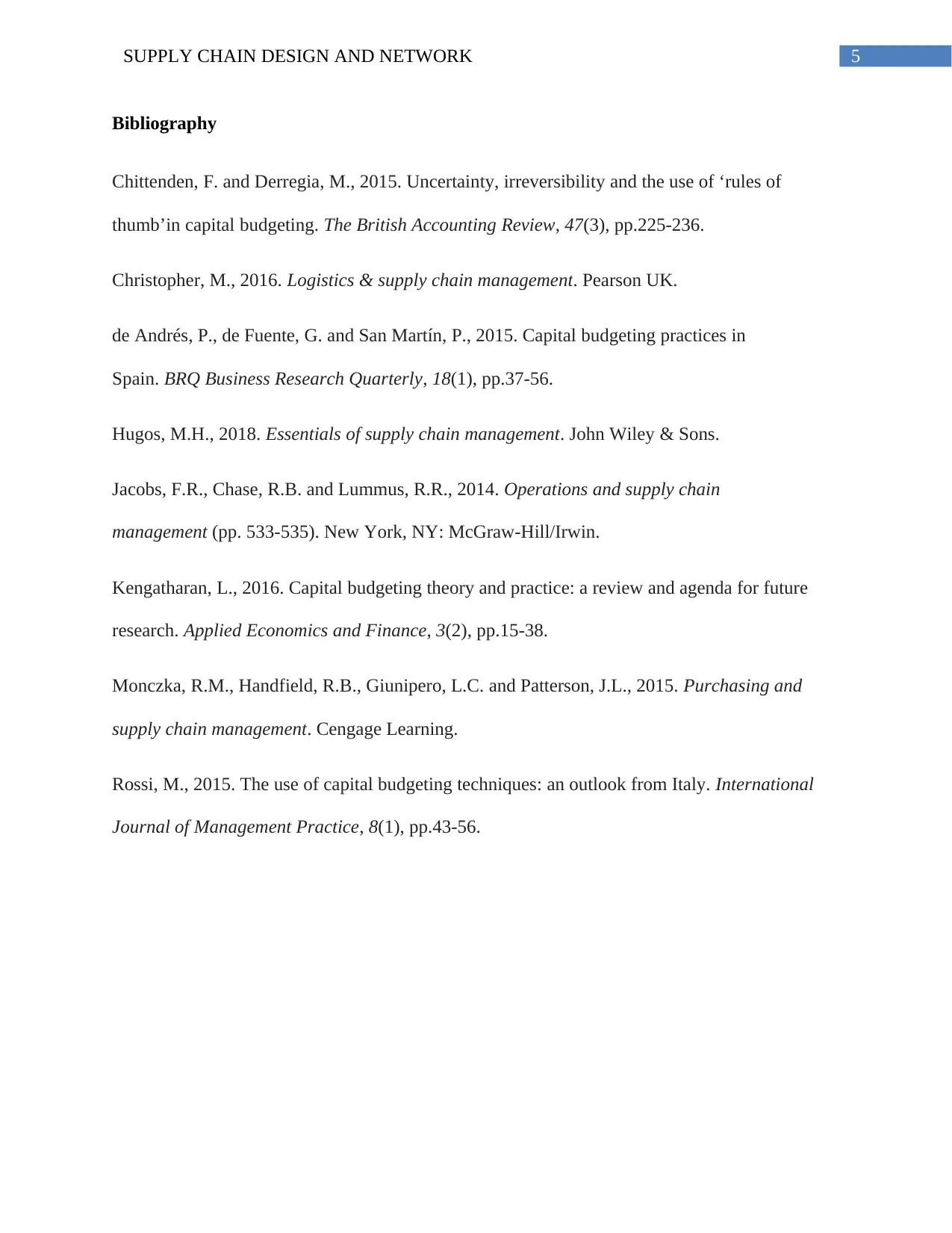
5SUPPLY CHAIN DESIGN AND NETWORK
Bibliography
Chittenden, F. and Derregia, M., 2015. Uncertainty, irreversibility and the use of ‘rules of
thumb’in capital budgeting. The British Accounting Review, 47(3), pp.225-236.
Christopher, M., 2016. Logistics & supply chain management. Pearson UK.
de Andrés, P., de Fuente, G. and San Martín, P., 2015. Capital budgeting practices in
Spain. BRQ Business Research Quarterly, 18(1), pp.37-56.
Hugos, M.H., 2018. Essentials of supply chain management. John Wiley & Sons.
Jacobs, F.R., Chase, R.B. and Lummus, R.R., 2014. Operations and supply chain
management (pp. 533-535). New York, NY: McGraw-Hill/Irwin.
Kengatharan, L., 2016. Capital budgeting theory and practice: a review and agenda for future
research. Applied Economics and Finance, 3(2), pp.15-38.
Monczka, R.M., Handfield, R.B., Giunipero, L.C. and Patterson, J.L., 2015. Purchasing and
supply chain management. Cengage Learning.
Rossi, M., 2015. The use of capital budgeting techniques: an outlook from Italy. International
Journal of Management Practice, 8(1), pp.43-56.
Bibliography
Chittenden, F. and Derregia, M., 2015. Uncertainty, irreversibility and the use of ‘rules of
thumb’in capital budgeting. The British Accounting Review, 47(3), pp.225-236.
Christopher, M., 2016. Logistics & supply chain management. Pearson UK.
de Andrés, P., de Fuente, G. and San Martín, P., 2015. Capital budgeting practices in
Spain. BRQ Business Research Quarterly, 18(1), pp.37-56.
Hugos, M.H., 2018. Essentials of supply chain management. John Wiley & Sons.
Jacobs, F.R., Chase, R.B. and Lummus, R.R., 2014. Operations and supply chain
management (pp. 533-535). New York, NY: McGraw-Hill/Irwin.
Kengatharan, L., 2016. Capital budgeting theory and practice: a review and agenda for future
research. Applied Economics and Finance, 3(2), pp.15-38.
Monczka, R.M., Handfield, R.B., Giunipero, L.C. and Patterson, J.L., 2015. Purchasing and
supply chain management. Cengage Learning.
Rossi, M., 2015. The use of capital budgeting techniques: an outlook from Italy. International
Journal of Management Practice, 8(1), pp.43-56.
⊘ This is a preview!⊘
Do you want full access?
Subscribe today to unlock all pages.

Trusted by 1+ million students worldwide
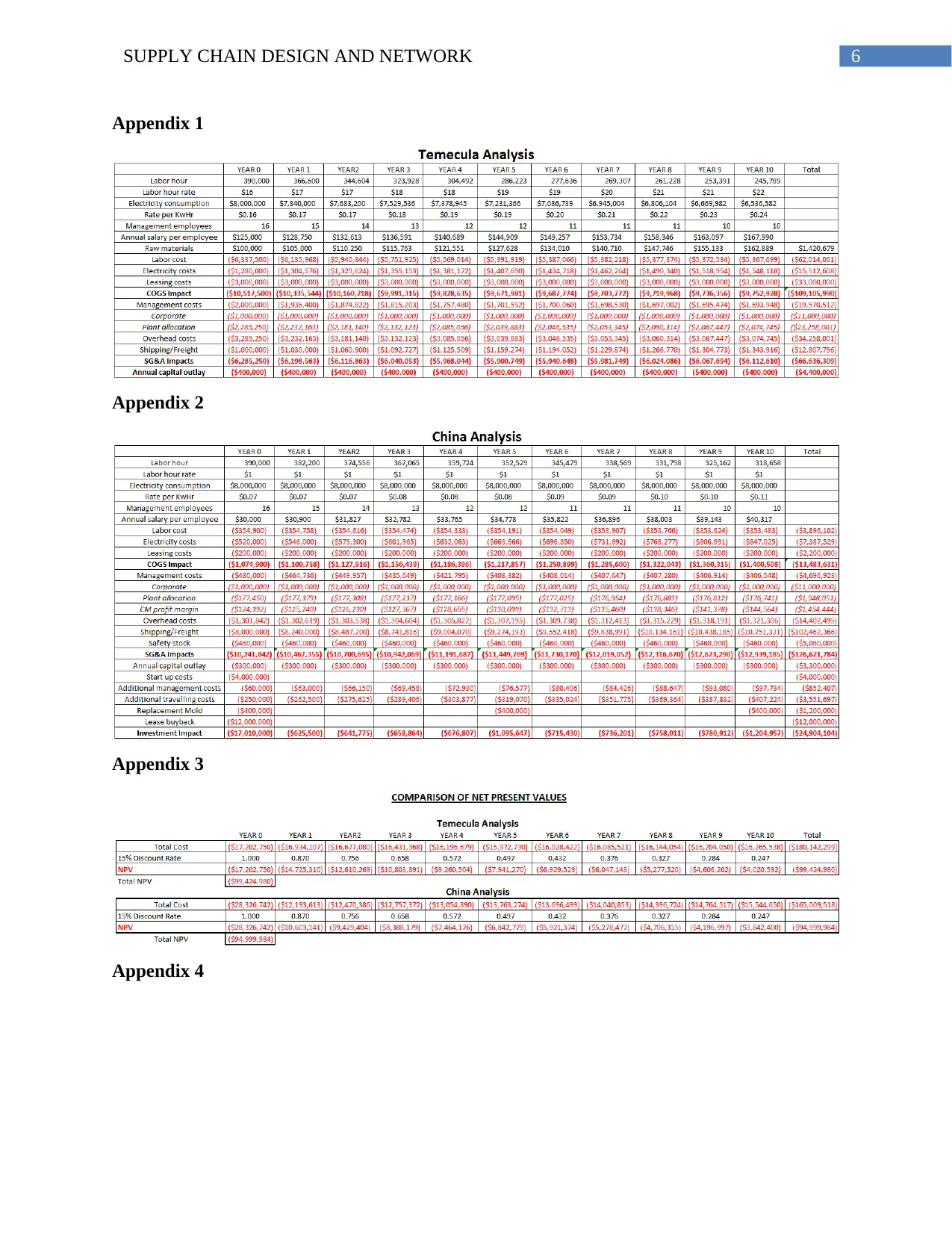
6SUPPLY CHAIN DESIGN AND NETWORK
Appendix 1
Appendix 2
Appendix 3
Appendix 4
Appendix 1
Appendix 2
Appendix 3
Appendix 4
Paraphrase This Document
Need a fresh take? Get an instant paraphrase of this document with our AI Paraphraser
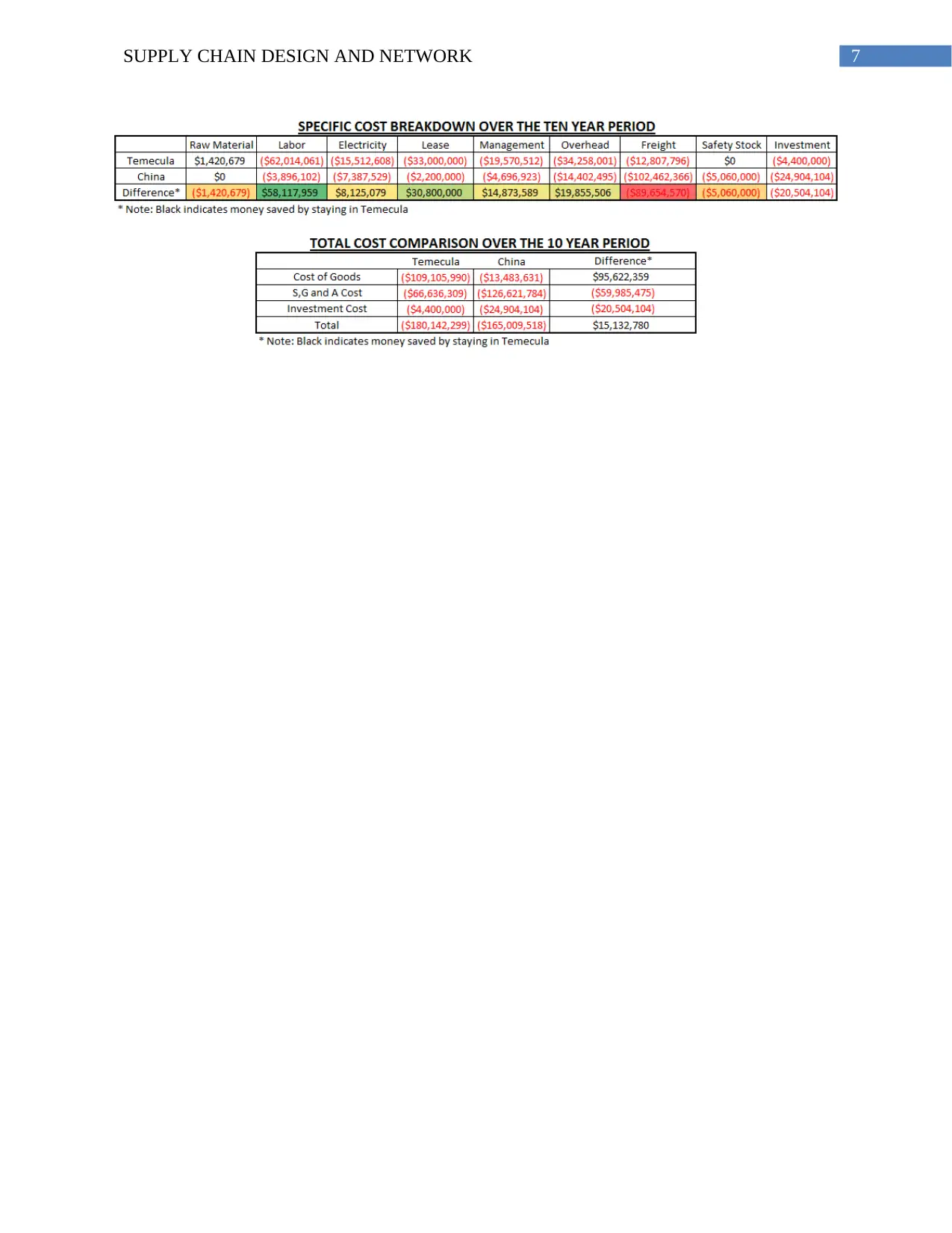
7SUPPLY CHAIN DESIGN AND NETWORK
1 out of 8
Related Documents
Your All-in-One AI-Powered Toolkit for Academic Success.
+13062052269
info@desklib.com
Available 24*7 on WhatsApp / Email
![[object Object]](/_next/static/media/star-bottom.7253800d.svg)
Unlock your academic potential
Copyright © 2020–2025 A2Z Services. All Rights Reserved. Developed and managed by ZUCOL.




